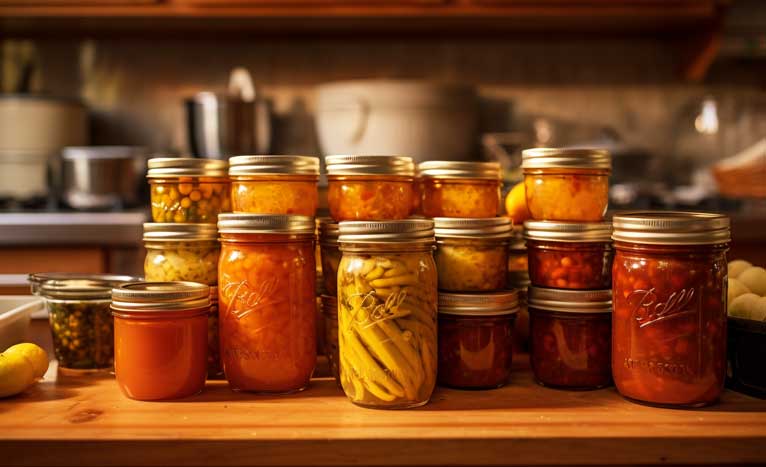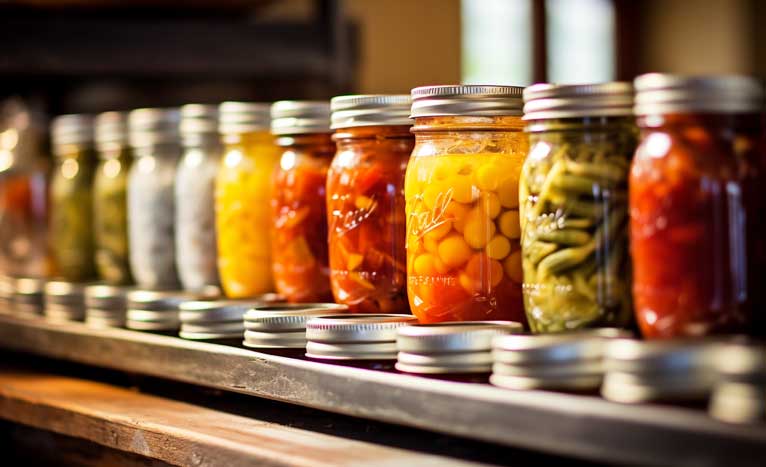If you know me, you know I love food storage. There are a variety of ways to store up your harvest or food from the store, but I definitely have a few favorites! This is my comprehensive guide on the age-old debate of canning vs. freezing for food preservation.
If you are wanting to learn how to build a food storage or want to have a better organization process for it, check out my Prepper’s Guide to Food Storage.
I swear my guide hasn’t left my kitchen counter because I am currently in the middle of preserving my summer harvest! I am canning, freezing, and freeze-drying, and my guide helps me stay organized and is my go-to reference for my food storage!

Canning: Preserving Tradition
There are two different methods of canning: water-bath canning and pressure canning. The key difference between these methods lies in the types of foods they are suitable for and the processing techniques involved.
Water bath canning is primarily employed for high-acid foods like fruits, jams, jellies, and pickles. In this method, jars of prepared food are submerged in a large pot of boiling water and heated to a specific temperature. The heat kills bacteria, yeasts, and molds, effectively preserving the food.
On the other hand, pressure canning is necessary for low-acid foods such as vegetables, meats, poultry, and soups. These foods require higher temperatures to eliminate the risk of botulism, a potentially deadly toxin. Pressure canners create airtight environments with high pressures and temperatures that destroy harmful microorganisms.
While water bath canning is relatively simpler and requires basic equipment, pressure canning demands specialized pressure canners to ensure safety when canning low-acid foods.
In your canning manual, it will most likely have directions for canning in glass jars like these or tin cans. The preference and most common canning method nowadays is glass jars. I would suggest to use glass jars, but do what you feel comfortable with.
I use my All-American pressure canner. I have had it for a few years now, and I love how sturdy it is. A presto pressure canner is a common canner used as well! I made the investment into pressure canning by purchasing my All-American canner because I wanted to get a canner once and never again!
The Canning Process
Preparation: Food is washed, peeled, and sliced as needed. Jars and lids are sterilized to prevent contamination.
Filling: Prepared food is packed into sterilized jars, leaving appropriate headspace to allow for expansion during processing.
Processing: Jars are sealed and heated in a water bath or pressure canner, depending on the food's acidity. This kills microorganisms and creates a vacuum seal.
Cooling and Storage: Sealed jars are cooled, and the lids should pop down, indicating a successful seal. Canned goods can be stored in a cool, dark place for up to a year or more.
This is a general process for how canning works. Of course, you need to follow the instructions laid out in the recipe. I love to follow the directions in the manual that came with my canners because they will walk you through the exact steps for your canner.
After canning and practicing, you will become comfortable to branch out and follow other recipes and adjust as needed!
Pros of Canning
- Long shelf life
- Retains flavors and textures
- No need for electricity for storage
- Suitable for low-acid foods
Cons of Canning
- Requires specialized equipment
- Time-consuming process
- Some loss of nutrients due to heat
For those interested in getting started with canning, essential equipment such as canning jars and canning kits are readily available on Amazon.

Freezing: The Modern Alternative
Freezing is a popular and convenient method of food preservation that involves lowering the temperature of food to inhibit the growth of microorganisms. It is particularly useful for fruits, vegetables, meats, and prepared dishes.
I love freezing food so much! It is convenient and especially useful if you are using a vacuum sealer to create space in your freezer. Freezing is incredible, the only downside is if you lose power, your food can go bad. This is why it is important to have a variety of methods to preserve and store food.
The Freezing Process
Preparation: Food is blanched (briefly boiled) before freezing to destroy enzymes that can cause flavor and texture changes. In my Prepper’s Guide to Food Storage, I have a list of foods that need to be blanched for your reference.
Packaging: Blanched food is cooled and packed in airtight containers or freezer-safe bags to prevent freezer burn.
Freezing: Food is placed in the freezer at a temperature below 0°F (-18°C) to halt bacterial growth.
Storage: Frozen foods can be stored for several months to a year, depending on the type of food and packaging.
Pros of Freezing
- Quick and easy process
- Retains color and nutrients
- No specialized equipment required
- Suitable for a wide range of foods
Cons of Freezing
- Limited storage time compared to canning
- Dependent on electricity for long-term storage
- Texture changes in some foods upon thawing
For those considering freezing as their preferred preservation method, look for high-quality freezer bags and vacuum sealers on Amazon. These tools ensure your frozen foods remain well-protected from freezer burn and maintain their freshness.
Choosing the Right Method

Factors to Consider
Type of Food: Some foods are better suited for canning (low-acid foods) while others excel with freezing (fruits, vegetables).
Storage Time: Canned foods can last longer, making them ideal for building a long-term food supply.
Convenience: Freezing is quicker and requires less specialized equipment, making it more accessible for beginners.
Energy Dependence: Canning is less reliant on electricity for long-term storage.
Texture and Flavor: Freezing generally preserves textures and flavors better, but canned foods can maintain their qualities if properly processed.
Verdict
In the battle of canning vs. freezing, there's no one-size-fits-all answer. Both methods offer unique advantages and challenges that cater to different needs and preferences. Canning preserves tradition and offers long-term storage, while freezing embraces modern convenience.
Ultimately, your choice should align with the types of foods you wish to preserve, your available resources, and your desired shelf life. Whichever method you choose, both canning and freezing empower you to enjoy homegrown or locally sourced foods well beyond their harvest seasons.
As you embark on your food preservation journey, remember that experimentation and practice will guide you toward mastering the art of canning and freezing, ensuring a well-stocked pantry and the delight of delicious, preserved flavors year-round.

